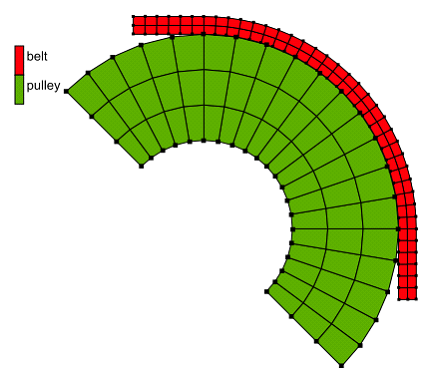Contact Bodies
There are two types of contact bodies: deformable and rigid. Deformable bodies consist of finite elements and rigid bodies consist of (undeformable) geometric entities: curves (2-D) or surfaces (3-D). In CivilFEM, all bodies are considered deformable bodies.
Based on the set of elements defining the body, CivilFEM automatically determines which nodes and element edges (2-D) or faces (3-D) are on the outer surface of the body. Depending on the contact procedure used, they are used to determine if contact will occur, either with the body itself or with another contact body.
Note that a body can be multiply connected (have holes in itself). It is also possible for a body to be composed of both triangular and quadrilateral elements in 2-D or tetrahedral, pentahedral and brick elements in 3-D (provided that connected elements share faces with the same number of nodes). Beam elements and shells are also available for contact; the algorithms for beam contact will be discussed separately. Both lower-order (linear) and higher-order (quadratic) elements may be used. One should not mix continuum elements, shells, and/or beams in the same contact body.
Each node and element should be in, at most, one body. It is not necessary to identify the nodes on the exterior surfaces as this is done automatically. The algorithm used is based on the fact that nodes on the boundary are on element edges or faces that belong to only one element. As all nodes on free surfaces are considered contact nodes (each node on the exterior surface is treated as a potential contact node), if there is an error in the mesh generation such that internal holes or slits exist, undesirable results can occur.
To define rigid body a deformable body must be defined and then its properties to be changed (i.e. material Young modulus) or/and constrain all degrees of freedom of the structural element.
Initial Contact
At the beginning of the analysis, structural elements should either be separated from one another or in contact. Structural elements should not penetrate one another unless the objective is to perform an interference fit calculation. Profiles are often complex, making it difficult to determine exactly where the first contact is located. Before the analysis begins (increment zero), if one of the deformable structural elements has a nonzero motion associated with it, the initialization procedure brings it into first contact with the deformable structural element. No motion or distortion occurs in the deformable bodies during this process.
At initial contact detection, a node contacting a body is projected onto the contacted segment of this body. Due to inaccuracies in the finite element model, this might introduce undesired stress changes, since an overlap or a gap between the node and the contacted segment will be closed. The option for stress-free initial contact forces a change of the coordinates of a node contacting a deformable body, thus avoiding the stress changes. In combination with the glue option, a similar effect can be obtained; however, the overlap or gap remains.
